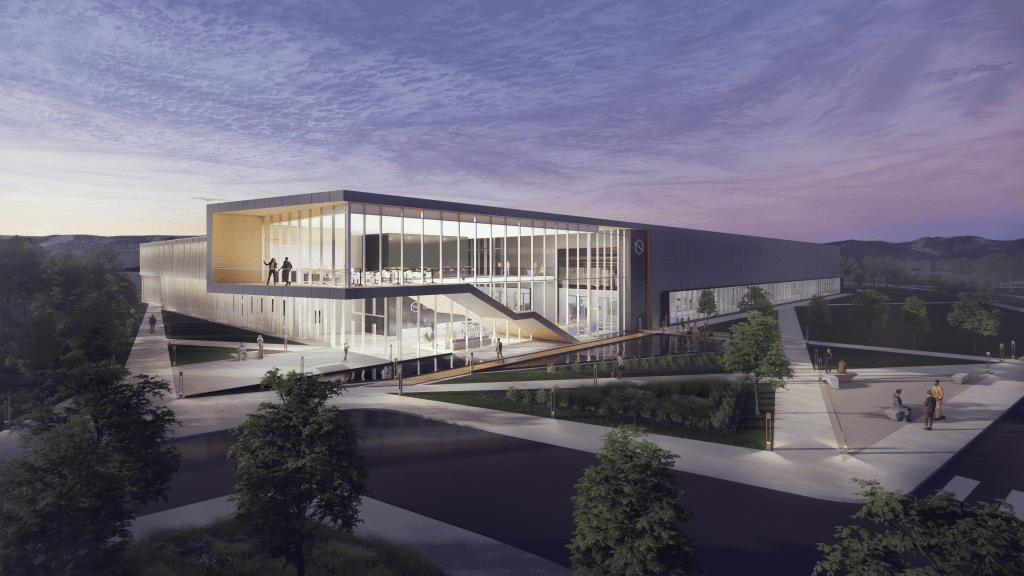
CRB Launches SlateXpace, A Groundbreaking New Design-Build Solution for Life Science Facilities
CRB, a leading design-build firm specializing in tech and life science facilities, recently announced the launch of SlateXpace, a groundbreaking design-build solution for life science facilities. SlateXpace is a modular, multi-modal facility solution for the development and manufacture of Advanced Therapy Medicinal Products (ATMP) that offers life science organizations unprecedented construction speed, development flexibility, manufacturing adaptability, and budget control.

The days of building facilities with massive, expensive, and inflexible equipment for a single product are quickly passing, and the need for biotech and biopharma organizations to develop a diverse pipeline of products from monoclonal antibodies to cell and gene therapies is growing exponentially. Today, facilities need to be able to adjust quickly and cost effectively to capitalize on development successes, adjust to product setbacks, or meet unexpected public health needs.
CRB created SlateXpace (pronounced “Slate Space”) to meet this need and to deliver the “X” factor every emerging life science company needs to scale, pivot, and bring their novel products to market faster.
“SlateXpace was born out of CRB’s early involvement with cell and gene therapy and ATMP processes and facilities. We saw early on that there was a very diverse portfolio of therapies that were coming online and a lot of the players weren’t sure where each of those market segments were heading,” stated JP Bornholdt, Director or Technical Operations at SlateXpace and Facility Planning Specialist, Architect and Engineer at CRB.
“These industry players had a lot of products in preclinical, small scale development with a lot of potential. They just weren’t sure which would be the big winner,” he added. “We realized that a multi-modal solution was needed. Our customers needed something that could accommodate the development of multiple kinds of therapies.”
A Revolutionary Design-Build Solution for Life Science Facilities
Jacob Greenwood, Business Development Director at CRB, stated, “At CRB we strive to not just be aware of the newest and best capabilities out there, we want to create them. And that’s what we’ve done with SlateXpace. We’ve created the next generation of facilities. Multi-modal facilities are extremely important to our customers and really weren’t available until now.”
The SlateXpace design-build model is not only multi-modal, but it is also based on modular, prefabricated building processes. Building facility mods in a controlled, offsite environment enables higher quality construction and faster, more reliable project completion timelines that allow life science organizations to get up and running faster than ever before. The SlateXpace design-build approach empowers parallel construction of a facility core and shell while prefab mods are being built offsite, saving both time and money.
“Our multi-modal, prefab approach allows these facilities to get built in an unheard of amount of time. You want to be up and running as quickly as possible to beat your competitors to the market, which is particularly important for companies developing therapies with smaller markets, like for rare diseases,” added Bornholdt.
The benefits of SlateXpace for life science companies could be game-changing, allowing emerging biotech companies to scale strategically as their pipeline products advance through the development process. This ability to scale as the need emerges is critical to startups and emerging life science companies that often have more limited budgets in earlier phases of development.
“The key aspect is the flexibility of the systems and the equipment within the facility. If you look back at traditional biotech over the last decade you have a lot of specific, custom-built facilities that would scale up rather than scaling out in footprint,” shared Bornholdt.
“With SlateXpace companies now have the ability to start at a very small scale, maybe with just a few mods for preclinical work, and then expand these modules in a repeatable, scalable, and standard fashion that allows them to grow in a very natural and organic way without having to overinvest early. Startups and emerging companies often have little experience in capital projects and our approach reduces a good deal of risk for them.”
The repeatable, standardized modular approach, with the ability to customize each module, can create facility standardization across multiple sites, reduce training time, and also create a strong, consistent quality assurance environment that is conducive to regulatory site inspection approvals and FDA process compliance.
Each GMP compliant SlateXpace module is designed to be equipment agnostic—equipment may slide in and slide out to accommodate different development modalities. This enables operators to adjust to what SlateXpace calls the “X-Factor” of new processes, technology advancements, emerging opportunities, or shifting patient needs. The modules come in a variety of setups and configurations ranging from the SX20 module, which is up to 700 square feet, to the SX50 module with 3,800 square feet of customizable space. The SX20 is designed for smaller-scale, preclinical development whereas the SX50, known as the “Mother of All Suites”, is better suited toward later commercial development phases. SlateXpace’s design-build platform is equally applicable for greenfield facility projects as well as facility retrofits.
“We have a strong technical framework for each type of product. 80% of what we create is modular and 20% is customizable to adjust to that customer ‘X Factor,’” shared Bornholdt. “We’ve put in enough inherent flexibility into the design that we can accommodate customization to our customer’s unique requirements.”
SlateXpace’s new facility solution is groundbreaking, yet the team knows that an intimate understanding of a life science organization’s current and future needs is critical to success. The CRB and SlateXpace team of engineers and architects puts great emphasis on the discovery phase of a project to ensure the right mix of modules and capabilities is delivered to its customers. The key is delivering a design-build solution for life science facilities that work for the unique needs of each customer.
“When we’re about to do a design, we sit down with our client to understand their business drivers and process needs. Ultimately, we take all of this information and try to understand their processes and where they’re coming from. We then use that information to develop a mix of modules if they might need several. Even though the platform is modular, there is ample opportunity to mix and match and customize your design with SlateXpace,” stated Bornholdt.
“This isn’t just a box we’re selling. We won’t just deliver the module and leave and say ‘Hey, good luck!’ Our team ensures each of our projects addresses regulatory issues. We work closely with the client to identify risks and mitigate these risks. This is about facilities and standard operating procedures for the facility once it’s up and running. This isn’t just giving them the hardware; we’re giving them the software, too, and standing by with them as they install it, so to speak,” stated Bornholdt.
“Our process architects put a lot of work and thought into these facility designs to allow them to switch seamlessly between modalities. All the regulatory concerns are addressed up front in the design,” shared Greenwood.
“We’ve partnered up with Germfree for the module fabrication and with CAI on the Commissioning, Qualification, and Validation portion of projects. Germfree and CAI are very experienced vendors, so our customers will be in very good hands to have a turn-key approach from concept through commissioning and validation,” he added.
“There are always going to be early adopters and people that push back. We’re seeing speeds in the life sciences that we’ve never seen before due to the pandemic. SlateXpace is a great solution to accelerate development timelines. We encourage push back. We want a lot of questions. Our customers are really smart people and we’d love to have a conversation so we can answer their questions and fill in the gaps of understanding about our technology,” stated Greenwood.
SlateXpace launched in September 2020 and has already completed a number of conceptual test fits for several development modalities. These feasibility studies are a key milestone towards delivery and installation of the first SlateXpace modules. So far, Bornholdt and Greenwood see a lot of excitement in the industry about the SlateXpace platform and the concept has been “selling itself.”
For anyone interested in learning more about SlateXpace, Greenwood encouraged reaching out to their local CRB Business Development Director or visit SlateXpace.com for more detailed information.
- About the Author
- Latest Posts
Steve brings nearly twenty years of experience in marketing and content creation to the WorkForce Genetics team. He loves writing engaging content and working with partners, companies, and individuals to share their unique stories and showcase their work. Steve holds a BA in English from Providence College and an MA in American Literature from Montclair State University. He lives in Frederick, Maryland with his wife, two sons, and the family dog.




